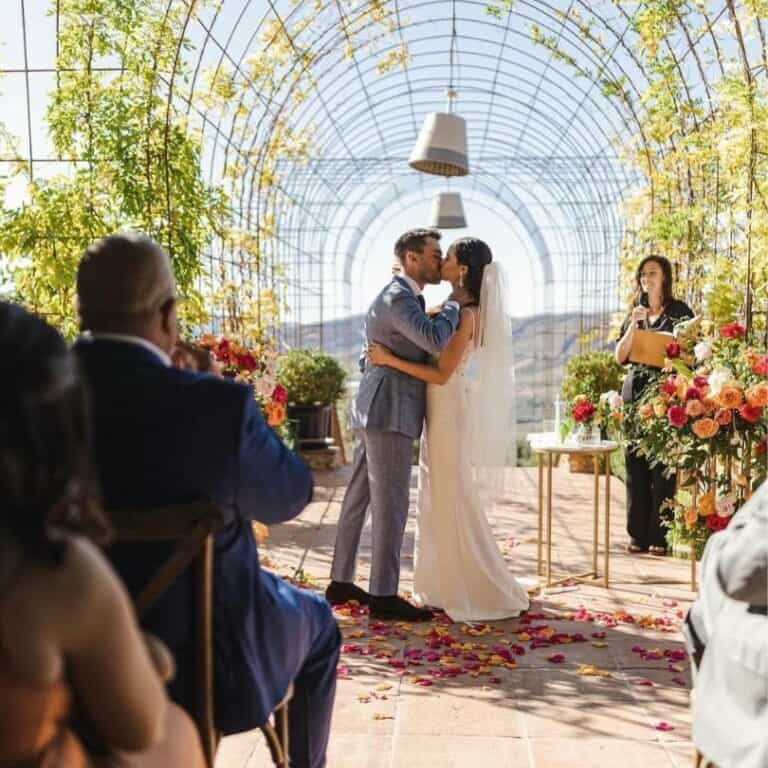Naming ceremonies, a tradition steeped in history across cultures, offer a momentous way to welcome a child. Family or Naming Celebrants play a key role in infusing these ceremonies with meaning, tradition, and personal touches.
Naming ceremonies, an age-old tradition to welcome a new member into the family and community, are experiencing a transformation. As societies evolve, so do these ceremonies, adapting to reflect modern sensibilities, cultural diversity, and personal values. Today, we see a significant influence of contemporary trends, reshaping these ceremonies to be more inclusive, personal, and reflective of the family’s unique identity.
At The Academy of Modern Celebrancy we’re here to support you, so we’ve come up with some magical and meaningful Naming Ceremony Ideas for Celebrants to add to your ceremony toolkit:
1. Candle Lighting Ceremony
A candle lighting ceremony at a naming ceremony is a symbolic ritual where candles are lit to represent blessings, wishes, or guiding lights for the child’s life. Rooted in various cultural practices, lighting candles symbolizes illumination, guidance, and warmth.
Typically, close family members, including parents, siblings, and grandparents, light the candles. The number of candles can vary based on preference; it could be one for each family member or a single candle to represent the unity of the family.
This customizable ceremony allows for personal touches based on the family’s traditions or the significance they wish to impart.
Candle Lighting at a Naming Ceremony: Leading the Ritual
As a celebrant, instruct each participant to light a candle while sharing a personal wish or blessing.
Personalizing a Candle Lighting Ceremony
Select candles based on the family’s cultural background or use colours that have specific meanings to the family.
2. Symbolic Tree Planting Ceremony
At a tree planting ceremony during a naming ceremony, a tree is planted to symbolize the child’s growth, strength, and development. The tree is usually planted in a meaningful location, like the family’s home or a place of special significance to them. Planting rituals are found in many cultures, and represent growth, life, and continuity.
Personalizing a Tree Planting Ceremony
The choice of tree can vary; some families might select a tree based on cultural significance, personal preference, or one that thrives in their local environment. This ceremony can be a deeply personal and poignant part of the event.
These trees hold significant meanings in various cultural traditions and are often chosen for symbolic ceremonies, including naming ceremonies, for their deep-rooted symbolism.
- Oak Tree: Symbolizes strength, endurance, and wisdom. Revered in many cultures, including Celtic and Norse traditions.
- Willow Tree: Represents healing, growth, and harmony. In some cultures, it’s also associated with flexibility and resilience.
- Cherry Blossom (Sakura): In Japanese culture, it symbolizes beauty, the transient nature of life, and new beginnings.
- Olive Tree: A symbol of peace and friendship, deeply rooted in Mediterranean cultures.
- Banyan Tree: In Hinduism, it represents immortality and the divine creator Brahma. It’s also a symbol of life and fertility in various Asian cultures.
- Baobab Tree: In African cultures, it’s known as the “Tree of Life” due to its life-sustaining properties and is a symbol of strength, resilience, and community.
- Birch Tree: Symbolizes renewal and purification. In Celtic cultures, it’s seen as a sign of new beginnings and protection.
- Maple Tree: Represents balance, promise, and practicality. In some Native American tribes, it’s seen as the tree of offering, generosity, and balance.
- Cypress Tree: Often associated with mourning but also signifies eternal life. In various cultures, it’s a symbol of the underworld but also represents endurance and resilience.
- Pine Tree: Symbolizes longevity, wisdom, and immortality in many cultures. It’s also associated with endurance through challenging times.
Tree Planting at a Naming Ceremony: Leading the Ritual
Select a plant or tree with the family, and lead a collective planting during the ceremony. Make sure the planting hole is large enough before the ceremony, and ask each family member to say a blessing as they add soil to the roots.
You could also share some words about the symbolism of the type of tree you are planting.
3. Storytelling
Storytelling is a universal tradition used to impart wisdom and values. Choose or invite family members to share stories that resonate with the family’s values or the child’s future aspirations and integrate elements from the family’s cultural background into the story.

3. Ritual of Names
Names hold great importance in all cultures, often reflecting identity and heritage. Explain the name’s origin and meaning. Incorporate any family naming traditions. If the name has foreign roots, include elements from that culture in the ceremony.
The Hindu tradition of Namakarana involves the baby’s name, often chosen based on astrological and religious considerations, being whispered in the child’s ear by the father.
4. Sand Ceremony
A sand ceremony is a symbolic act often used in naming ceremonies to represent the unity of the family. It involves different coloured sands, each colour representing a family member or a specific aspect of the child’s life. During the ceremony, each participant pours their sand into a single vessel, blending the colours. This act symbolizes the coming together of individual lives into one unified family.
This ceremony holds special significance in situations where a family is blending or in multicultural families, as it visually represents the unique contributions of each member, creating a unified whole.
Leading a Sand Ceremony at a Naming Ceremony
A celebrant plays a pivotal role in guiding this ceremony. They orchestrate the flow, explain the symbolism to guests, and often add personalized elements to the ritual. Their presence ensures the ceremony unfolds seamlessly, lending it a professional yet intimate touch.
A naming celebrant may lead readings, poems or promises for the child or incorporate other naming ceremony rituals to complement the Sand ceremony
5. Water Blessing Ceremony
A water blessing at a naming ceremony is a ritual where water is used to symbolically cleanse or bless the child. Historically, many cultures, including Christian, Hindu, and some indigenous traditions, have used water in naming or baptismal ceremonies to represent purity, life, and a new beginning.
The water blessing is usually carried out by the celebrant or a significant family member. Water is gently sprinkled or poured over the child’s forehead, sometimes accompanied by blessings or prayers. The specifics of the ritual can vary based on the family’s cultural background or personal preferences.
6. Naming Ceremony Time Capsule
Time capsules have been used throughout history to capture and preserve the essence of a particular time for future generations. A time capsule ritual at a naming ceremony involves creating a container filled with items and messages that encapsulate the current moment, to be opened at a significant future date. This ritual is rich in history and holds various cultural significances:
It adds a dimension of continuity and connection between the past and the future, creating a bridge between the child’s birth and a significant future milestone, often their 18th birthday.
It can be especially meaningful in capturing the essence of the family’s life and the world at the time of the child’s birth, offering a unique glimpse into their origins when they are older.
How to use a time capsule as part of the Naming Ceremony
- Container Preparation: The time capsule is typically a durable box or container that can withstand the test of time. Families may choose containers made of materials like stainless steel or aluminum to prevent deterioration.
- Item Selection: Families, and sometimes guests, contribute items to the capsule. These can include personal notes, photos, current newspaper clippings, baby mementos, and even digital messages or videos.
- Sealing the Capsule: Once filled, the capsule is sealed. The celebrant often leads this part of the ceremony, marking the significance of preserving memories for the future.
Personalizing the Time Capsule
- Involving Family and Friends: Encourage guests to bring items that hold personal or cultural significance.
- Choosing Items Reflecting Current Times: Include artefacts that represent the current era, technology, or popular culture.
- Future Messages: Including letters or recorded messages to the child to be read or viewed in the future adds an emotional touch.
7. Circle of Support
A Circle of Support at a naming ceremony is a meaningful ritual that involves the gathering of family and friends in a circular formation around the family or the child. This circle symbolizes unity, protection, and community support.
In various cultures, similar concepts are observed. For instance, in some Native American tribes, such as the Ojibwe Nation, significant emphasis is placed on communal involvement in the child’s naming, where an elder or respected community member often plays a vital role in determining a child’s name based on spiritual guidance and the child’s perceived life path.
The specific way a Circle of Support is conducted can vary. Participants might share blessings, prayers, or good wishes for the child. In some cultures, songs, dances, or other ceremonial acts might accompany the formation of the circle. The ritual underscores the community’s role in the upbringing and welfare of the child, cementing a sense of belonging and shared responsibility.
The importance of ritual for Naming Celebrants
These innovative ideas can transform a naming ceremony into an extraordinary event. Each ritual can be adapted to the family’s preferences, ensuring the ceremony is as unique as the child it celebrates.
As celebrants, it’s essential to keep exploring and incorporating fresh ideas to offer personalized and meaningful experiences. Stay ahead of trends and continue creating magical moments for families.
If you’d like to learn how to become an exceptional naming celebrant, check out our Certified Naming Celebrant Training you can check out our Master Celebrant Training programme that includes certification in Wedding, Funeral and Naming Celebrancy.
Jennifer Claire
Jennifer is the Director of the leading celebrant training company, The Academy of Modern Celebrancy as well as the Founder of The Celebrant Directory, supporting over 600 celebrants globally.
Jennifer run a 2.5k community of celebrants who she dedicates her time to helping them grow their businesses and taking celebrancy from a hobby to a lifestyle.
Jennifer heads up the global Celebrant Industry Awards and the global celebrant summit, Celebrantopia each year!
A celebrant herself since 2010, she knows what it takes to make it in the industry and trains the best celebrants out there across the UK, Europe and the USA.
Take the Quiz to find out if you have what it takes!
Download the Ultimate Guide to becoming a Celebrant & find out how you can make this happen!

If you liked this article you may enjoy ...
Training to be an accredited Celebrant in Spain
Celebrancy is a growing profession in Spain fueled by demand for personalised, non-religious, and interfaith ceremonies, destination weddings and robust ex-pat communities from the UK and beyond. If you’re considering Training to be an accredited Celebrant in Spain, there are a few things you’ll need to know, so we’ve put together this handy guide to…
5 Essential Skills for Celebrants
Have you ever dreamt of officiating life’s most cherished moments – the joyous vows of a wedding ceremony, the heartwarming welcome of a newborn child, or the dignified farewell of a loved one? Celebrants play a crucial role in weaving these threads of life into meaningful experiences. But what exactly does it take to become…
Wedding Celebrant Outfits: 2024 Style Guide
As a wedding celebrant, you’re not just officiating a ceremony; you’re contributing to the overall atmosphere of the special day. While the focus is naturally on the couple, your attire plays a role in setting the tone and ensuring you look professional and polished. And in 2024, we’re throwing the rulebook out of the window!…
As featured in










